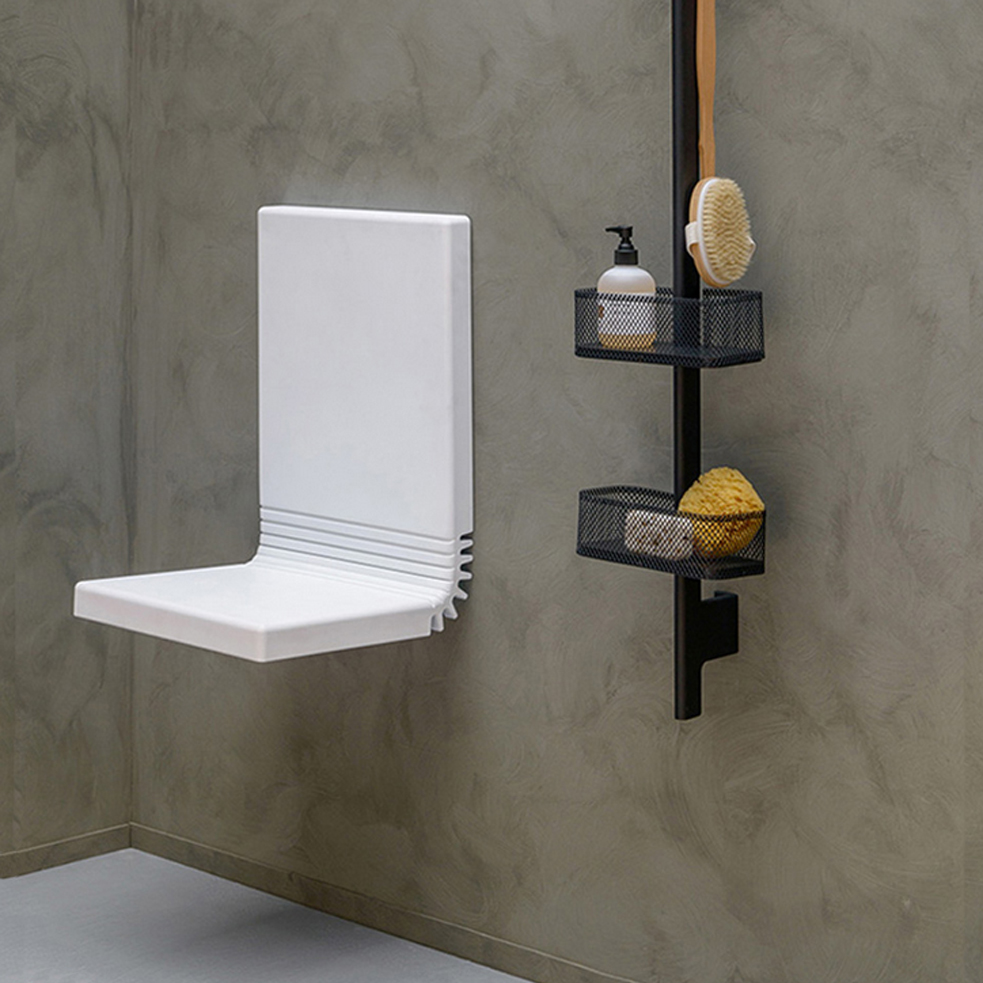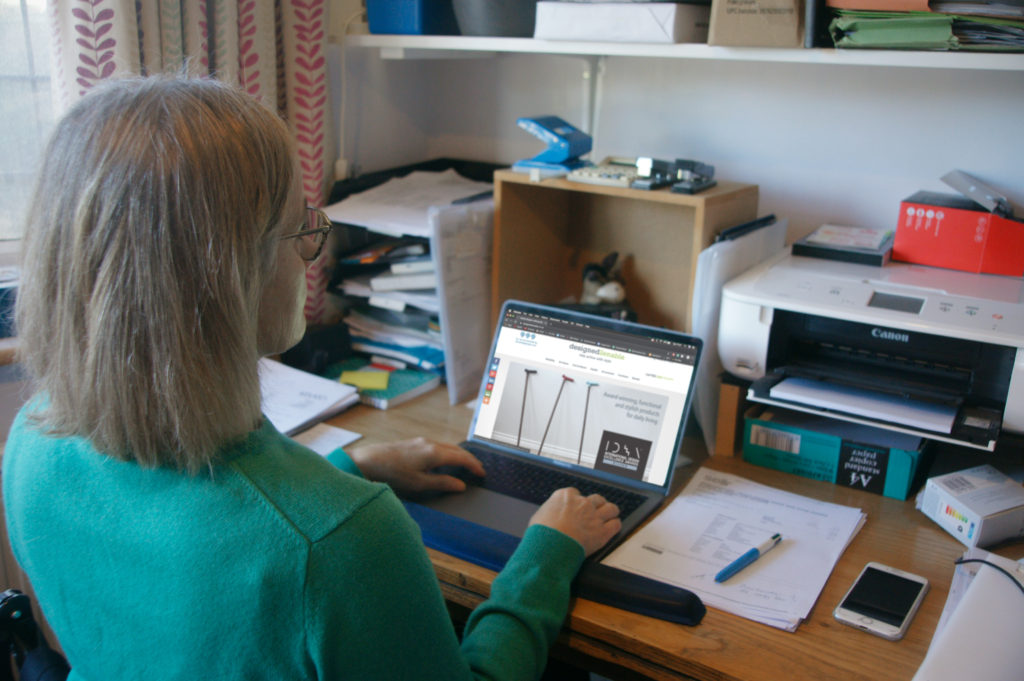One of the first sites I ever discovered when I was searching for good-looking disability products was designed2enable. I don’t remember quite how I came across it, but I remember being really excited when I clicked through and saw a curation of items that were actually…attractive. Something, if you’ve read my blog or followed me on Instagram, is one of the things I’m now most interested in.
So, I’m delighted that for this week’s post, I had the opportunity to interview the lovely Katherine Pyne, co-founder of designed2enable. We talk about her business, the wider assistive product market, and how she makes it work as a disabled entrepreneur. I learned a lot, and I hope you enjoy it!
Katherine also kindly loaned me some products from their curation that can make life easier/more comfortable/more glam for disabled people, including a heating pad blanket, a beautiful blue badge case, and more. I’ll be doing individual mini reviews of these products over on my Instagram Stories) over the next few weeks (they’ll also be saved in a highlight on my profile).
What is designed2enable?
designed2enable is an online retailer that specialise in stylish and functional products for daily living.
The business is the brainchild of husband and wife team, Katherine & John Pyne. The company ethos is to enable equality through design by selecting products that customers will be happy to use and to have in their home – products of style and interest.
Why did you decide to start your own business?
The idea for the business came several years before we started it. I had had a spinal injury at the age of 30 and once we had got our lives back on track, we had our daughter.
She grew up, and as I had more time, we decided that it would be good to start our own business and work from home.
The idea of a stylish mobility store had been in the back of our minds for some time. It was born from our personal frustration with the lack of stylish bathroom grab rails and, wheelchair gloves for women that weren’t cycling gloves or masculine black gloves. And it stemmed from there!
Can you walk us through the types of products that you offer?
Our product range includes many award-winning products. We source products that range in price from both high-end and for the more budget-conscious, so that there is something for everyone.
We also have products that are not found in other mobility shops which sets us apart. For example in our bathroom range, the Decor Walther and the Ever Life Design range are very different, expensive – yes, but they have a great impact and are beautifully designed.
Our range includes walking aids, products for the house and home, exercise devices and mobility accessories – anything really that makes life a little easier, and hopefully more joyful, for our customers.

How do you feel that the market for functional products for disabled people has changed over the years? Do you feel as though things are better, or are there still challenges towards making them more mainstream?
Our initial research for products was slightly depressing, we found few well-designed products to launch our business on, so we had to bide our time, that was around 7 years ago.
We searched again, a year or so later and the situation had improved, and we could see a change in the thinking behind the design of mobility products. The designers were starting to recognise the need to improve the aesthetics of their product design.
Being part of the EU has been helpful, the Scandinavian countries are leaders in modern contemporary design and many of our products are designed and sourced from there. Things are improving, and it is an exciting time for the disability industry.
Design is at the forefront of the movement which, in turn, encourages the manufacturers to up their game. The main challenge is in keeping prices affordable – disability can be an expensive business and many customers have limited funds, so we try to ensure that our store has something for everyone.
Can you talk a bit more about the challenges of finding affordable products?
However, some of the cheaper products on the market, such as the white plastic bathroom aids, have been designed for function only, using standard/affordable materials and as these are purchased by the general public and by the NHS for hospitals, care homes and care in the community, the demand is reasonably high, which then brings the manufacturing cost down. And many of these items are probably produced in China…

For the more aesthetic looking mobility aids, more focus (and therefore cost) is spent on the design, the materials used will be of higher grade and the demand will be less as they will not fit the NHS budget. Therefore the end consumer cost will be more.
We find that many of our products come from the Scandinavian countries who have the reputation for great design but their cost of living is quite high which will reflect on the products that they produce and manufacture.
What kinds of products would you like to be able to sell but haven’t been able to source – or what kind of products are your customers looking for?
We often get enquires for shopping trolleys but there is not a great selection available and for some reason, there is such a price war on other online shops (no names mentioned!) that we are unable to compete.
But we do feel that there is a gap in the market here for a sturdy and stylish shopping trolley that will give the user some support with their mobility, with a built-in seat. We do have the Rollz Flex shopping trolley which is a great product but it would be lovely to have other options to offer as well.
You and your husband both live with disabilities, can you tell me a little about them and how they impact your work?
John has MS and I had a horse-riding accident which left me paraplegic, with chronic pain, and an independent wheelchair user.
John’s MS is not visible to others, but he lives with spasms, fatigue and a bad back which is quite challenging. Weirdly, he can’t walk far but he can still ride his bike! He was a committed lycra-clad, road racing cyclist in his youth and we used to spend hours out together, John on his mountain bike and me on my horse, charging around the countryside.
Working from home, together, enables us to manage the business between us, which allows for relapses and time out and pacing ourselves when we need it.
Do you have anything specifically set up to help you balance your health with your work?
Just being able to work from home is a blessing, having our own accessible bathroom to hand and not having to answer to anyone else when you are tired or need a break, keeps the stress levels down.
We are very conscious of not over stretching ourselves and would not want the business to grow further than we can comfortably manage.

How do you balance deadlines, expectations from customers and suppliers, and other business responsibilities with looking after your health?
Our deadlines are making sure that we get the orders out to our customers in good time as we really appreciate that customers need the products that they have ordered for their mobility, they are our priority.
A proportion of our products are dispatched by our suppliers so the communication between us and them is important.
So, the fact that we do not have to physically wrap and dispatch everything makes it workable for us – we dispatch a lot of the smaller stuff and we usually do a run to the mailing drop-off points or, if it suits us better that day, we arrange courier collection.
Do you have plans in place for unexpected flare ups?
John’s condition is more prone to flare-ups than mine and he does have days where he must take it easy but then I am fully able to keep things moving.
Occasionally, I have a chronic pain flare up which results in a bad night and following day but then John can manage. Between us, we cope, I think you have to know your limits and not over stretch yourself but disaster can happen to anyone at any time, so just do your best and live your life!
In the worst-case scenario, we would put a sign up on the website explaining that orders might be delayed slightly but we have never, yet, had to do that.
What has been the biggest challenge of running a small business whilst disabled?
Space! Wheelchairs and disability equipment take up a lot of space and so we have really had to organise ourselves to create the extra storage space for stock and the office.
Do you feel you have received much support as disabled business owners? If not, what would have been helpful for you?
Possibly not but then I don’t think we have been the most proactive at seeking the support. A business mentor would have been great and of course, tapping into extra funding for the business would have helped.
What advice would you give to someone with a disability who is looking to start their own business?
Find something that you are passionate about and think carefully to make sure that you will be able to manage the responsibilities, and the stress of running the business with your health condition.
Consider finding someone else to partner with as it helps to share the pressure as working on your own can be quite lonely.
It will be hard work and can be relentless but can also be very rewarding. The disability industry is at an exciting, dynamic stage so if your chosen business is within this field, I would encourage anyone to tap into their personal experiences which should give you the edge on your competitors.
And don’t be afraid to ‘put yourself out there’, followers on social media love to see the face/es behind the business, and network with other disabled bloggers and business owners where you will also find fantastic support.
A huge thank you to Katherine for taking the time to answer my questions! You can check out designed2enable here!
The company has kindly offered a discount code for my followers which will give 5% off your order using code INSTA5. This is not an affiliate code and I do not get any commission from it. And it can only be used once per customer up until the 5th January 2020.
As always, if you’d like to support me and my work (aka help prevent over-reliance on Instagram and its bloody algorithm), all I ask is that you subscribe to my newsletter.


It is great that the couple who are suffering from physical disabilities can work at their home and sell products suitable for people with disabilities. I was thinking about designing items in CafePress and selling it to clients, but they expect you to pay to sell and I do not want to do it. My father would become angry if I spent too much money designing and selling my items online.